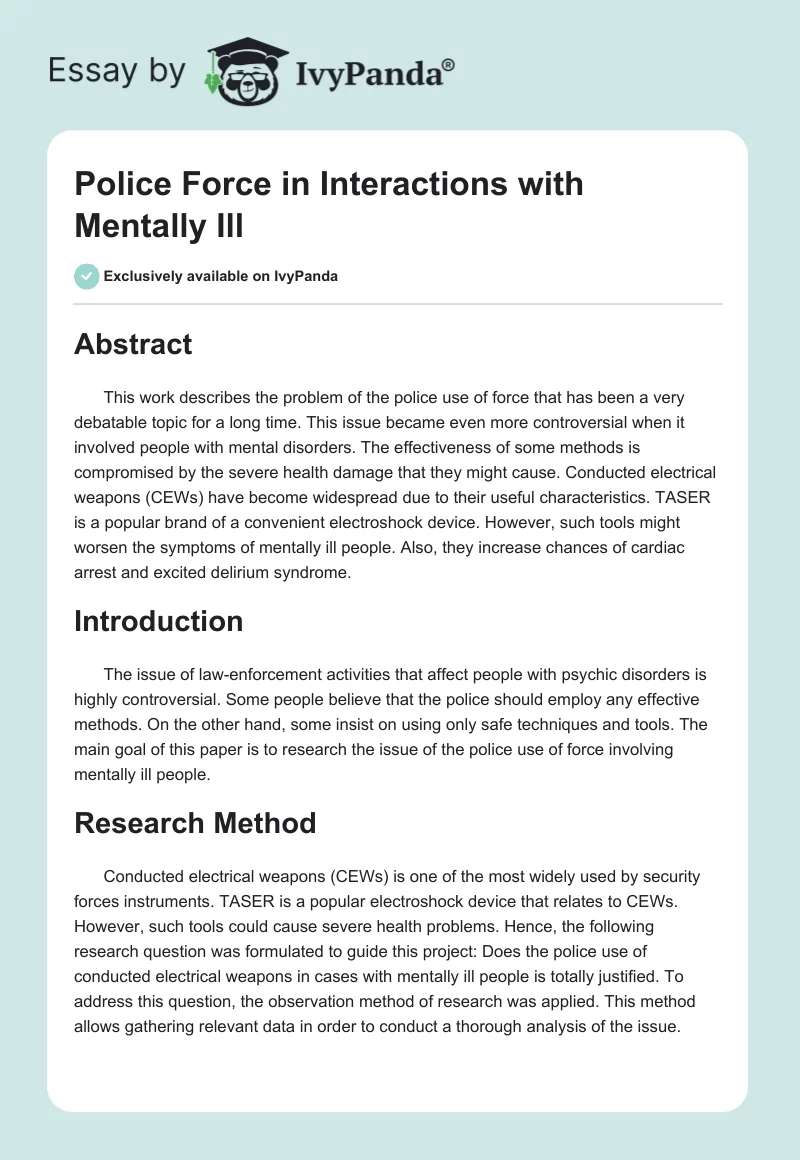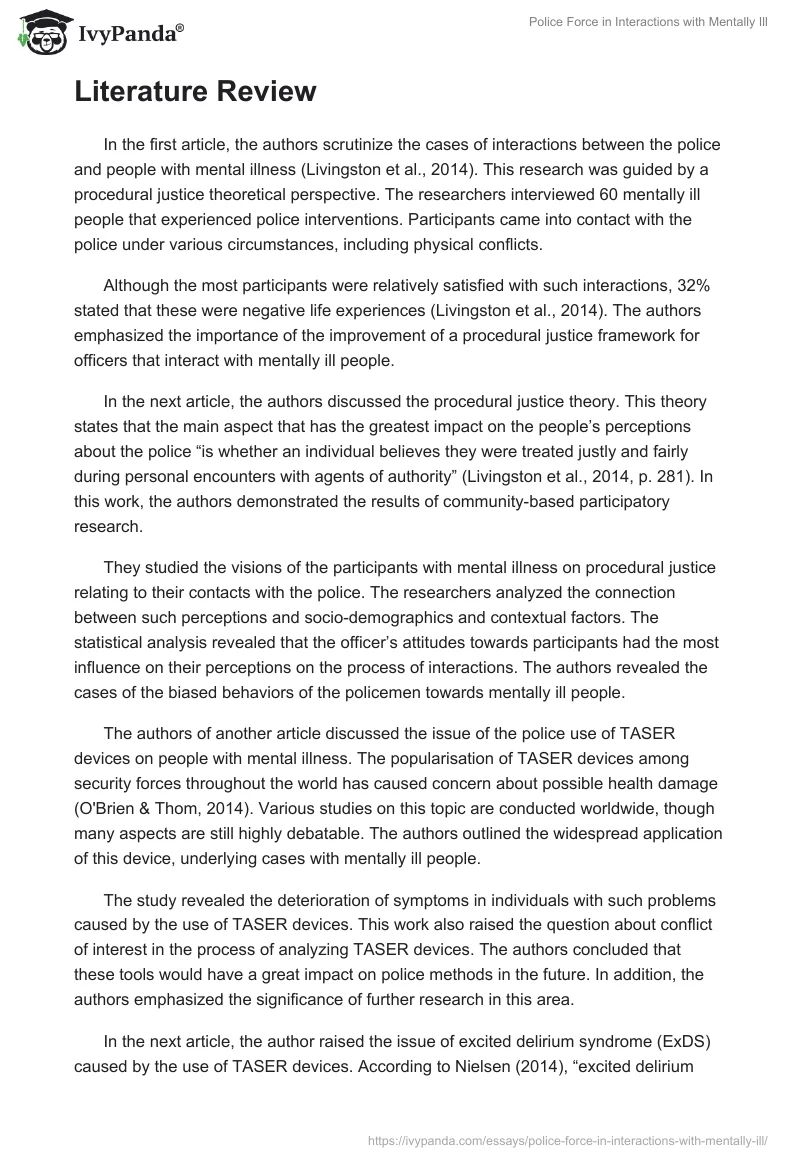Abstract
This work describes the problem of the police use of force that has been a very debatable topic for a long time. This issue became even more controversial when it involved people with mental disorders. The effectiveness of some methods is compromised by the severe health damage that they might cause. Conducted electrical weapons (CEWs) have become widespread due to their useful characteristics. TASER is a popular brand of a convenient electroshock device. However, such tools might worsen the symptoms of mentally ill people. Also, they increase chances of cardiac arrest and excited delirium syndrome.
Introduction
The issue of law-enforcement activities that affect people with psychic disorders is highly controversial. Some people believe that the police should employ any effective methods. On the other hand, some insist on using only safe techniques and tools. The main goal of this paper is to research the issue of the police use of force involving mentally ill people.
Research Method
Conducted electrical weapons (CEWs) is one of the most widely used by security forces instruments. TASER is a popular electroshock device that relates to CEWs. However, such tools could cause severe health problems. Hence, the following research question was formulated to guide this project: Does the police use of conducted electrical weapons in cases with mentally ill people is totally justified. To address this question, the observation method of research was applied. This method allows gathering relevant data in order to conduct a thorough analysis of the issue.
Literature Review
In the first article, the authors scrutinize the cases of interactions between the police and people with mental illness (Livingston et al., 2014). This research was guided by a procedural justice theoretical perspective. The researchers interviewed 60 mentally ill people that experienced police interventions. Participants came into contact with the police under various circumstances, including physical conflicts.
Although the most participants were relatively satisfied with such interactions, 32% stated that these were negative life experiences (Livingston et al., 2014). The authors emphasized the importance of the improvement of a procedural justice framework for officers that interact with mentally ill people.
In the next article, the authors discussed the procedural justice theory. This theory states that the main aspect that has the greatest impact on the people’s perceptions about the police “is whether an individual believes they were treated justly and fairly during personal encounters with agents of authority” (Livingston et al., 2014, p. 281). In this work, the authors demonstrated the results of community-based participatory research.
They studied the visions of the participants with mental illness on procedural justice relating to their contacts with the police. The researchers analyzed the connection between such perceptions and socio-demographics and contextual factors. The statistical analysis revealed that the officer’s attitudes towards participants had the most influence on their perceptions on the process of interactions. The authors revealed the cases of the biased behaviors of the policemen towards mentally ill people.
The authors of another article discussed the issue of the police use of TASER devices on people with mental illness. The popularisation of TASER devices among security forces throughout the world has caused concern about possible health damage (O’Brien & Thom, 2014). Various studies on this topic are conducted worldwide, though many aspects are still highly debatable. The authors outlined the widespread application of this device, underlying cases with mentally ill people.
The study revealed the deterioration of symptoms in individuals with such problems caused by the use of TASER devices. This work also raised the question about conflict of interest in the process of analyzing TASER devices. The authors concluded that these tools would have a great impact on police methods in the future. In addition, the authors emphasized the significance of further research in this area.
In the next article, the author raised the issue of excited delirium syndrome (ExDS) caused by the use of TASER devices. According to Nielsen (2014), “excited delirium syndrome is defined as delirium coupled with extreme agitation” (p. 1). ExDS is a serious disorder that requires rapid medical intervention. Approximately 8% of the affected die from this medical condition (Nielsen, 2014). Although some specialists consider ExSD as a real ExDS only in cases of fatality, most researchers admit the existence of other factors that might relate to this syndrome.
It was noticed that ExDS often occurred in cases of violent interaction with the police officers. More than 7,000 security force agencies in the United States apply CEWs including the use of TASER devices. The author stated that there is abundant evidence that ExSD developed in people who came into contact with the police that applied TASER to them. This study demonstrated the direct connection between the development of this syndrome and the application of TASER devices.
The authors of the next study discussed the problem of cardiac arrest caused by the use of TASER devices. The study described 8 cases of unexpected cardiac arrest occurred due to the electric impulses produced by a TASER (Zipes, 2014). The affected did not have cardiovascular symptoms. However, several possibly suffered heart disease. The injured became unconscious right after they got an electric shock. The clinical data demonstrated that TASER devices could cause ventricular fibrillation in people, but the chances are low.
However, TASER chest shots were banned. Also, the article revealed some statistics regarding the use of TASER devices. The authors stated that “the deployment of TASER weapons has more than doubled in England and Wales, from 3500 in 2009 to 14500 in 2010” (Zipes, 2014, p. 109). The fact that a shock lasting 5 seconds can cause ventricular fibrillation was proved by data analysis.
In the next work, the author discussed misconceptions relating to the CEWs. TASER devices are getting more popular among security forces (Jauchem, 2015). However, there are many questionable aspects regarding the use of this law-enforcement tool. Therefore, some misconceptions might be seen in various publications on this topic. The author thoroughly analyzed reports from different scholar sources.
He concluded that the most of the presented information about possible dysfunctions and health damage associating with TASER devices is not reliable. The popular opinion that TASER electrical shock can lead to death is deceptive. The author emphasized the importance of “clarification of these misconceptions” (Jauchem, 2015, 53). He concluded that CEWs are very convenient law-enforcement tools, and erroneous information should be excluded from the constructive discussion on this issue.
Analysis
Several articles reveal the high level of dissatisfaction with the police methods among people with mental problems. Other studies show that CEWs are widely used by police officers during law-enforcement activities. Also, these devices are applied to people with mental problems. However, the study by O’Brien highlighted that the use of TESAR worsens the symptoms in people with such dysfunctions. Other studies demonstrate the negative effects of CEWs on the people’s health that include ExDS and cardiac arrest. As ExDS is a mental medical condition, it is highly important to avoid using CEWs on people with psychic disorders. However, some specialists doubt this information and call for further research.
Conclusion
The problem of CEWs still has many unclear aspects. Scientists argue their effect on the people’s health. However, various incidents involving the use of CEWs demonstrate that a certain connection might be found. Therefore, it is highly necessary to continue research in this area to collect more relevant data that will help to draw firm conclusions.
References
Jauchem, J. R. (2015). TASER® conducted electrical weapons: Misconceptions in the scientific/medical and other literature. Forensic Science, Medicine, and Pathology, 11(1), 53-64.
Zipes, D. P. (2014). Can TASER electronic control devices cause cardiac arrest? Web.
Livingston, J. D., Desmarais, S. L., Greaves, C., Parent, R., Verdun-Jones, S., & Brink, J. (2014). What influences perceptions of procedural justice among people with mental illness regarding their interactions with the police? Community Mental Health Journal, 50(3), 281-287.
Livingston, J. D., Desmarais, S. L., Verdun-Jones, S., Parent, R., Michalak, E., & Brink, J. (2014). Perceptions and experiences of people with mental illness regarding their interactions with police. International Journal of Law and Psychiatry, 37(4), 334-340.
Nielsen, A. A. (2014). Excited delirium syndrome and conducted electrical weapons. Web.
O’Brien, A. J., & Thom, K. (2014). Police use of TASER devices in mental health emergencies: A review. International Journal of Law and Psychiatry, 37(4), 420-426.


